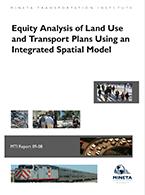- 408-924-7560
- mineta-institute@sjsu.edu
- Donate
Equity Analysis of Land Use and Transport Plans Using an Integrated Spatial Model
This paper describes a study to investigate how a spatial economic model can be used to evaluate the equity effects of land use and transport policies intended to reduce greenhouse gas emissions. The Activity Allocation Module of the PECAS (Production, Exchange, and Consumption Allocation) Model the Sacramento region is used to simulate two scenarios for the year 2035 arising from a recent planning process, "Business-As-Usual" and "Preferred Blueprint." Advanced aggregate travel models and activity based travel models have been applied to evaluate distributions of travel time and cost effects of transport and land use policies across different socio-economic groups. But the PECAS model system, with its representation of the interactions among the transport system and the rest of the spatial economic system, enables an evaluation of the distributions of a wider range of economic impacts, including wages, rents, productivity, and consumer surplus, for segments of households, labor, and industry. In this study, the PECAS model is applied to illustrate the distributional measures that can be obtained from this type of model and to provide insights into the equity effects of different transport and land development patterns. The results show that a more compact urban form designed around transit stations may reduce travel costs, wages, and housing costs by increasing accessibility, which can lead to substantial net benefits for industry categories and lower income households. Higher income households may be net losers, since their incomes are more dependent on reduced wages, they are less willing to switch to higher density dwellings, and they are more likely to own their own home.
|
CAROLINE RODIER, PhD Dr. Caroline Rodier is a senior researcher at the University of California, Berkeley. Her major areas of research include transportation and environmental planning and policy analysis. She has extensive experience applying land use and transportation demand models to evaluate the travel, economic, equity and air quality effects of a wide range of transportation and land use policies, including intelligent transportation systems technologies, high occupancy vehicle lanes, transit improvements, road pricing, and land use control measures. Most recently, she has applied the Sacramento PECAS model with the SACSIM model to evaluate the equity, consumer surplus, and producer surplus of the Blueprint Plan for the Sacramento region. Dr. Rodier has also provided extensive research support to the California Air Resources Board in their development of the scoping plan for Assembly Bill 32, the Global Warming Solutions Act, including an international review of the modeling evidence on the effectiveness of transit, land use, and auto pricing strategies. |
|
JOHN ABRAHAM, PhD Dr. John Abraham has been involved in computer simulations of transportation systems since 1989, when he developed commercial software for pipeline simulations. In 1992 he began to study urban systems, emphasizing models of the interaction between land use and transportation. Dr. Abraham´s 1994 M.Sc. thesis explored the locational choices of multi-worker households in an urban setting by extending the state-of-the-art in behavioural modelling techniques. His 2000 PhD thesis investigated calibration and validation processes for urban models.
|
|
JOHN D. HUNT, PhD Dr. John Douglas Hunt is a professor in Transportation Engineering and Planning in the Civil Engineering Department at the University of Calgary. Dr. Hunt received his B.Sc. at the University of Alberta in 1981 and his PhD at Cambridge in 1988. Dr. Hunt´s research interests include mathematical modeling of transportation-related aspects of human behavior, with primary areas of focus in the interaction between transportation and land use; stated response techniques for obtaining data for estimation of model parameters; and automobile parking behaviour and parking policy . His recent and on-going activities include: developing a land use and transport model of Edmonton using the MEPLAN framework; participating in a study to compare land use and transport models of Sacramento based on alternative modeling frameworks; advising two British Rail subsidiaries, Union Railways and European Passenger Services, on the forecasting of the demand for international rail services using the Channel Tunnel; conducting a study using stated response techniques to measure and quantify Calgarians´ attitudes to elements of urban form, including mobility, density, taxes and the environment; developing a model of mode and parking location choice in Calgary using the EMME/2 framework; investigating methods of representing the joint choice of workplace location, home location and travel mode to work using data collected in Calgary. Professor Hunt was the recipient of the departmental teaching excellence award in 2002. |
|
BRENDA DIX Brenda Dix works as a graduate student researcher at the Transportation Sustainability Research Center at the University of California, Berkeley. She is studying to earn her masters in Civil Systems Engineering in May 2010 and then plans to work as a transportation engineer/planner. Her research interests include ITS technology development and implementation as well as the land use and transportation connection and emissions reductions from the transportation sector. This is her first co-authored report. |
-
Contact Us
San José State University One Washington Square, San Jose, CA 95192 Phone: 408-924-7560 Email: mineta-institute@sjsu.edu






